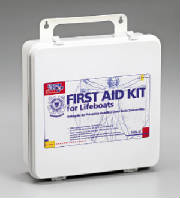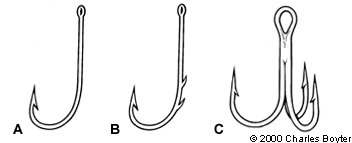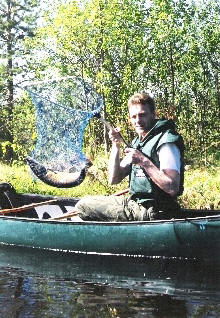|
It was a nice Saturday morning and the boat was loaded for a day catfishing with a new friend from the coast. Nothing was
different from any other morning other than the river was not moving as fast as normal. We caught several eaters and was set
up for some bigger ones. A small 5 pounder had hit the line and while removing it from the hook it fell in the boat and flopped
around, it grazed my ankle, nothing bad just a small scrape. I thought nothing of it, the fin had just made a mark on my ankle
and not even any blood, this was about 10 am. We fished all day and I had an increasing feeling in my ankle, by the time we
took out my ankle was swollen and red and had a lot of heat in it, I still thought that it was nothing, typical man thing.
I loaded the boat and began the cleanup after a day catfishing. My ankle was swollen and really sore.
Sunday morning
the ankle was so swollen and painful I could not walk on it, again I let it go and did not think much about it. On Monday
the thing was so bad I had to call the doctor. The doctor took one look and sent me to the ER. They said I had a bacterial
infection and said is was in the tissue and I needed a major IV antibiotic with an oral antibiotic for two weeks. I was thinking
all this from a little scratch. My doctor said it can kill and if not treated it can cause me to loose my leg. I started to
panic. I then calmed down and started doing some research.
To my surprise I found little on this. What I did find
was really interesting. Many water borne bacteria cause this and with the less than normal cold this winter the bacteria and
fungus in the rivers and lakes are at a much higher level. Many water borne bacteria are not harmful but some are, the flesh
eating strain of strep bacteria are all water borne and most can mutate to fight off the antibiotics. This is where the damage
control the doctors do comes to play, they first start off with a major injection of IV antibiotics of the strongest nature
for the person they can. Then it’s the same for the oral antibiotics. This lasts for anywhere from a week to three.
If the antibiotics work, if not then it’s back to the IV and a new antibiotic. This can go on if the person don’t
do what the doctors tell them, bed rest and elevation and not walking on it.
I did call the doctor back with some
questions and was able to talk to him at length about this. I found out that a simple thing like wiping it off with an antibacterial
wipe might have prevented it. Also simple wipes found in the medicine isle of any Wal-mart will prevent many infections and
complications. The type of bacteria varies with each body of water, the saving grace of this is that most can not survive
outside a host (I.E.: water, fish mucus, and muck off the rocks and such) the life span off their host is in minuets, therefore
a simple alcohol wipe will kill most if not all bacteria.
So just goes to show that a simple day fishing can lead
to a major endeavor with the hospitals and doctors and might even put you life at risk. So be careful and pay attention to
all the little scrapes and cut you get while fishing.
_________________
Winter Catfishing
Guys please read this and follow the rules of cold weather, we lost an angler this past week from not doing what he needed
to do and died from hypothermia.
Cold weather Catfishing
As the year comes to an end and the thoughts turn
to the holidays, I find myself looking at the days off from work and working the family schedule to create time to go catfishing.
As many of you know there are prime fish to be taken in the colder months. This is the prime big cat weather. They are stacked
in their winter holes and laying there feeding and gearing up for the spawn that is only a few months away now.
The
first thing to look at when catfishing in these months is SAFETY!!!!! I can not stress this enough. The water, wind, and air
temps all combine to make a very real danger of hypothermia and death if just one of the major rules of cold weather are ignored.
I will talk a little about this but highly stress that you do your homework for your area and on your body and mind to condition
your self for this endeavor. First, watch the weather and do not venture out during times of wet weather. The wetness will
zap your energy and drop your core temp so fast you will not be able to help your self. Second, dress for the weather, layers
and several of them, work best. Visit a military outlet store and ask about the "cold weather gear set up" this is a multi-layer
clothing system that is designed to keep the wearer warm in the worst of weather. It starts with a silk layer close to the
skin to help it breath and wick away moisture. Then two layers of insulating poly to make a barrier from the wind and cold.
Then a layer of wool that prevents the body heat from getting out, all this is toped with a layer of water resistant Gore-tech
to help stay dry. Seems like a lot but it isn’t and the cost is very little when weighted against your life. Third,
feet and hands, keep them warm and dry, feet are the first to loose feeling in the cold and they are the most important in
getting you out of a jam if something happens. Your hands need to be cared for with some lotion to keep them from drying and
cracking, get a good pair of mitten gloves. The kind from Dick’s that have the mitten cover over the fingers are lined
and warm. They also allow you to slide the mitten cover off to tie hooks and bait up. And best of all. They are machine washable.
Fourth, your head. 90% of body heat is lost through your head. A simple ball cap is not enough in this weather. A good stocking
hat with a ball cap over it is good but here again the military has the answer. It’s called a jeepers hat or watch hat.
This style has a flap that will cover your ears and has velcro on the strap to cover your cheeks and chin. With this set up
you can stay warm and dry. Always wear your PFD weather it be the vest or inflating type it will save your life in this weather.
Just remember that on average you have only 2 minuets to get your self out the water and start the drying process. Which brings
me to the next issue........... Survival tactics 101.........a small zip lock bag with a few items will save your life. In
a gallon zip lock bag you will need 3 small hand flairs the 5 min type will do and can be picked up almost anywhere. A box
of strike anywhere matches (preferably in a water proof case, also available at military outlet stores or wal-mart camping
section), a whistle, and an easy open pocket knife. These items will save your life. First the rivers and lakes all over provide
us with lots of good fire making material all pilled up close to the waters edge. A 5 min. flair dropped in one of these piles
and you have instant camp fire. I give you this from having had to use this very thing while trapping the northen territories
in Canada. I fell in a creek with the air temps at 17 deg and almost could not function. A quick rip of the bag and with in
three min I had warmth and with in 5 min. I had a good fire going. The other items will help but the fire is the most important
thing you will need. If you do fall in, the order of survival is simple. Out of the water, start fire, STRIP all wet clothes
off ASAP. Wet clothes will hurt more than help when trying to dry out. Hang the wet clothes far from the fire, they will freeze,
then shake the ice off and then warm by the fire. This is the quickest way to dry wet clothes in the winter. All the survival
skills needed to live is a cool head and a few things in a pocket. Well worth your life to take along.
Now lets get
to the fun, catfishing in winter. A little different approach is needed during this time of year. The fish are lazy and looking
for the most food with the least amount of effort. Weather you bank fish or boat fish it is most critical to find the fishes
hole. Some will move a little but most will stay in a short area. Just like deer hunting you need to find their feeding area
and their bedding area. Some will be close, with in a few yards some will be a few hundred yards away. The feeding area is
where ever the bait fish are schooling, the bedding area is where the fish can get out of the current and relax with very
little effort. Also you must think about the water temps. The fish want to be comfortable. This means you must find the water
that is closest to their ideal temps. This will be different through out the country so home work is needed here also. Big
baits and very slow presentation is needed. Also set your holes a little longer as the fish are moving slower so a normal
30 min hole might be an hour hole. Next, try getting your bait off the bottom about 2 feet, this will allow the sent to flow
better, a three way rig with a sinker dropper of 24 inches is what I use this time of year. Also add some thing to attract
the fishes attention. A lunker light or lighted bobber on the hook line will add to the appeal.
The tackle you
use should be fresh, change the line and don’t skimp here. New hooks and swivels. All is effected by the cold so you
want good quality fresh equipment. Your knives should be very sharp and a good heavy kitchen knife is a good winter addition.
The bait will freeze and a normal knife might brake trying to cut frozen bait. Also this time of year stay away from dip,
dough, and processed baits. Also leave the chicken livers home, use fresh fish and minnows as this is what the big cats are
looking for. Don’t forget the smaller fish are still biting for table fare but for trophy fish you will need to up size
the baits and be ready for a good fight. They won’t pull as much but they are dead weight this time of year.
For
bank fishing a good tent heater from coleman with a small 4x6 tarp will make for a much more enjoyable day on the bank. With
the tarp as a simple lean-to against the wind and the tent heater you can stay warm and comfortable for many hours. Also take
some food, not junk food but real food. A sandwich and a cake will help keep you going better than a bag of chips. Here again
I prefer the military surplus store. I find the new MRE meals just the ticket for winter fishing meals. They have all you
need to stay full and keep the body fueled for the cold. Also the night before a cold weather fishing trip have a good meat
and potatoes meal with bread and greens. These thing are slow to metabilise and will keep the body fueled longer and better
than any other meal other than a good thick hearty stew. So plan ahead and you will enjoy it better.
The last thing
you must remember is that the fish are still there just slower and more picky about their food. Take lots of pictures and
show your friends the monster fish you are catching when they call you crazy for fishing in the cold._________________
 |
 |
|
Must Have Take Along Items
Anyone that ventures into the outdoors knows what they will need for a day of fun for their outing that day. However they
must also take along a couple other things that they may not think about. First is the most important, they must have some
knowledge of first aid. I can not stress enough how important this is. If you don’t know first aid, take a class, all
American Red Cross Chapters offer them so there is no excuse for not knowing how to do simple first aid. Next is a simple
first aid kit, Wal-mart, K-Mart, and most other stores you go to every day have some type of first aid kit. A good camping
first aid kit can be bought from Wal-mart for under $15.00 and will have all you need. Now a good folding knife and keep it
sharp, some strike anywhere matches in a water proof holder, two or three small 5 minuet hand flairs and last a whistle. All
these items will save your life or someone else’s life. Next, learn to remove a hook, there are several ways but two
will cover any situation that comes along, the first is if the hook don’t go all the way through and the barb is in
the flesh. This will hurt but it must be done. Push the hook the rest of the way through and with cutting pliers cut the shank
of the hook and pull it the rest of the way out. Next is if the hook goes all the way through but only has a small chunk of
skin, flatten the barb with pliers and pull the hook back the way it went in. This is not recommended if the hook might have
gone through a blood vain or in deep in the flesh. Always see a doctor after being hooked, you will need a good antibiotic
and maybe a shot.
The simplest thing you can have with you on any outing is some antibacterial wipes. Pick some up the next time you are
at the store and put them in a ziplock bad and add a little alcohol every so often, they will last but the wipes will dry
out. This one item will keep you from having to worry about your hands getting nasty and you can keep any cut or scrape from
getting infected.
| click for links to |

|
| first aid kits I recomend |
Here is a good article on fish hook removel, it describes it better than I can and comes from a doctor and is how it's
done in the ER's around the nation. Just click the picture to go to the site on how to remove fish hooks.
| click for link to |

|
| how to remove fish hooks |
Now for those of you that like "doing it your self" here is a must read for you guys. The author has covered all you
need to know and this should be taken to heart and applied at all time when out enjoying nature
| click the picture for a link |

|
| to how to do it your self |
|
 |
 |